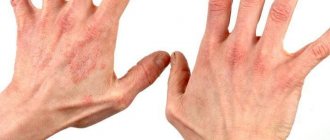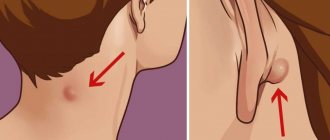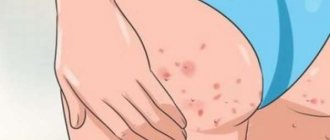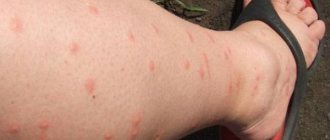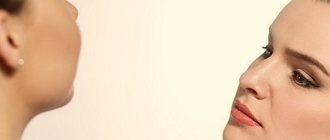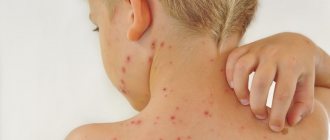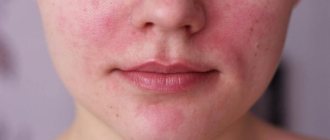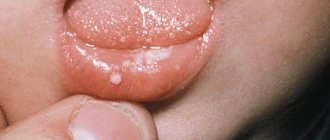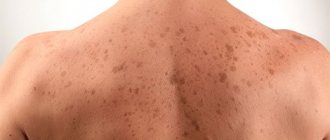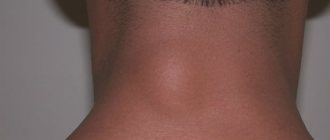Possible causes
The skin on the human body has some characteristics. Depending on the location of the rash, one can judge about a particular disease. Let's take a closer look:
- If the rashes have a round, scaly shape, we can talk about systemic lupus erythematosus, lichen of various etiologies, psoriasis;
- If the rash has a convex shape and constantly increases in size, this is typical for an allergic reaction and lymphoma;
- If the rash looks like hives, in most cases an allergy to a product or medication is diagnosed;
- In case of keratinization of rashes, the cause may be dermatitis of various etiologies;
- If the rashes are very itchy - lichen, psoriasis, dermatitis.
This is important: If you notice a red rash behind your child’s ears, contact a dermatologist.
Accurate diagnosis
photo of a rash behind the ear in a child
Making a diagnosis of herpes on the ear of a child or adult patient is not difficult for a doctor, and, as a rule, includes an external examination of the rash and additional laboratory tests.
During a clinical examination, the doctor identifies characteristic rashes that undergo the described changes from a small area of redness to crusts or ulcers that heal without a trace.
In complex clinical cases, it is possible to confirm the diagnosis of herpetic infection using modern diagnostic tests:
- tissue scrapings of rash elements can be examined using electron microscopy - characteristic electron-dense inclusions inside the cells are revealed;
- Determination of the genetic material of the virus using polymerase chain reaction makes it possible to identify the pathogen in any case of a rash behind the ears in an infant and in patients of other age groups.
Based on clinical examination and laboratory tests, the attending physician makes a diagnosis and determines how to treat herpes in the ear.
Ear allergy rash
According to medical statistics, most often a red rash in the ear area indicates an allergic reaction. Therefore, if you identify this symptom in yourself or your child, you should not panic too much. Think about what you ate and what you did the day before. Please note that allergies do not only occur due to ingestion of the allergen. In some cases, the disease manifests itself due to other factors:
- If we are talking about a child no older than two years old, the presence of a rash behind the ears may indicate underdevelopment of the gastrointestinal tract. This usually happens when a child is switched to adult foods too abruptly after breastfeeding or formula.
- Even if a person regularly eats a particular product without problems, sooner or later an allergy may develop to it. This usually happens when a person’s immunity is significantly reduced.
- Allergies can be seasonal. that is, it occurs during the flowering period in spring.
- If an animal lives in the house, a reaction may occur to the fur.
- Often, a rash occurs when wearing jewelry on the ears made of low-quality material.
- The cause of the development of the symptom may be the use of cosmetics, including powder and fabric softener with aromatic fragrances.
READ ALSO: DIY facial toner - effective recipes
What can the shape and color of the ear tell you?
On our project. More diseases. Ordering medications. First aid. Ask a Question. I am 32 years old. I lead a normal office lifestyle. I haven't been sick lately and haven't complained about anything. Today a spot appeared on the skin behind my ear. My wife discovered it only in the evening. It does not itch, does not hurt, is dry and flaky. Please tell me what it could be and how to treat it? A photo is attached to the question. Karina Sedrakovna Makvetsyan answers.
Hello Ivan, from your photo we can talk about psoriasis of the scalp; to clarify the diagnosis and prescribe a treatment regimen, I recommend an in-person consultation with a dermatologist. Based on the results of the consultation received, please consult a doctor, including to identify possible contraindications.
Order the required drug with delivery to the nearest pharmacy. Similar questions. Spots on the oral mucosa and weeping cracks. Good afternoon. Red spots with white edges appear in my mouth. For about 1.5 years now. Mainly on the lower lip. At the same time, they do not hurt or itch; I feel a crusty spot on my neck.
A week ago, a spot appeared on my neck, either covered with a thin crust, or flaky in this way. Since I do contact sports, I thought maybe I had torn off my skin somewhere on something, in one word, Birthmark. I visited an oncologist surgeon and a simple dermatologist surgeon. We don’t do this anymore. Oncology said it’s the most dangerous, the surgeon said to observe Red scaly spots on the chest and back.
Around July I discovered a spot on my chest. Oval in shape, with flaking dense scales. Around this time, I was about to move from one city to another, which made me a little worried and red-pink spots. I am 25 years old, male, weight 65 kg. From the age of 14, dandruff appeared on my head, eyebrows and forehead, and under it there were red spots. If you scratch it, water comes out and skin problems! I am 22 years old.
Please help, I don’t understand what’s happening to the skin, I suffered for a very long time with a crust on my head, I went to see a dermatologist. He prescribed Aplicort, I haven’t been using it for a long time Natalia Mazepa. Good afternoon I am 36 years old. Subscribe to us. News Health Mail. Information is provided for reference purposes. Do not self-medicate. At the first sign of disease, consult a doctor. Ru About the company Advertising. Editorial Our experts Agreement with consultants Help.
Somehow suddenly. The redness appeared at three o'clock and did not spread after a day's sleep.
Rash on ears and face
Often the patient complains of the appearance of a rash at the same time: on the ears and face. This symptom is characteristic of several pathologies at once, but still, there are some distinctive features. If the cause lies in an allergic reaction, in addition to hives and itching, accompanying symptoms rarely occur. However, if you continue to come into contact with the allergen, the rashes will begin to multiply throughout the body.
If the cause of the symptom on the face and ears is eczema, the reddish blisters sooner or later burst, clear liquid flows out of them and affects nearby skin. With dermatitis or psoriasis, the blisters become dry and then begin to peel off. If a patient is diagnosed with an erythematous type of dermatitis, swelling of the skin around the rash occurs.
This is important: Do not try to diagnose yourself at home. Contact specialists for this task.
What infectious diseases cause a rash?
In infectious diseases, the rash is accompanied by other symptoms, such as fever or itchy skin. In some cases, the cause of the rash is not clear and additional examinations are required.
Skin rashes can occur with the following infectious diseases:
• chicken pox; • erythema infectiosum; • measles; • rubella; • three-day fever; • meningitis; • rheumatic fever; • scarlet fever.
If a child's skin rashes are accompanied by an increase in body temperature, this is a sign of an infectious disease. The symptoms of the diseases are very similar in many cases, so even a doctor cannot always make a diagnosis right away. To make a final diagnosis, it is necessary to conduct blood tests and other tests (for example, nasopharyngeal discharge). This is a labor-intensive and unpleasant process for the child, but, fortunately, not always necessary. Nevertheless, in each case it is necessary to carefully diagnose, since for the future it is very important to know what diseases were suffered in childhood.
For example, if a woman is planning to have a baby, she should know if she has had rubella, since contracting it during pregnancy causes damage to the fetus. If rubella was suffered in childhood, the woman can be calm. Vaccination against rubella in those who have not been ill can significantly reduce the incidence of the disease in pregnant women and the risk to the fetus.
Speaking about vaccinations, it should be remembered that within a week after vaccination against measles, mumps and rubella, a child may develop a transient small, faint rash, which is accompanied by an increase in body temperature.
In this case, symptomatic treatment is carried out at the discretion of the doctor. Paracetamol may be used.
Rash on earlobe
Red spots on the earlobes in adults are a common symptom. Upon careful diagnosis, it turns out that the cause is skin irritation from constantly wearing jewelry. This usually happens when using low-quality material or due to the heavy weight and sharp shape of the earrings.
READ ALSO: Proper care for problem skin: causes, stages of care
In addition to jewelry, cosmetics can also affect the appearance of your earlobes. For example, a new hair shampoo, conditioner or face cream to which a woman is allergic. The skin of the earlobe is very vulnerable, so irritation can occur even from contact with hair. To solve this problem, it is enough to give up the provoking agent or jewelry, and in the near future the skin will cleanse itself.
Causes of fungal infection behind the ears
The following can provoke the growth of fungus behind the ears:
- puberty in adolescents (increased production of sebum from the sebaceous glands due to hormonal imbalance);
- hereditary manifestations of excessive work of the sebaceous glands;
- hormonal disorders and gynecological diseases in women, in men with testicular tumors, obesity;
- if you abuse spicy, salty or fried foods;
- bad habits (smoking, alcohol);
- weakness of the immune system;
- acute, infectious and chronic diseases;
- overwork, psychosis, stress;
- disorders of the gastrointestinal tract of non-infectious etiology, disorders of the endocrine glands.
Associated symptoms
Ear allergies, in addition to the presence of a rash, also have other associated symptoms:
- There is severe itching;
- If the skin is damaged (due to severe scratching), an inflammatory process may occur;
- When infected, discharge of various types occurs;
- In case of an allergic reaction, the area behind the ear may become swollen;
- Periodically clogs his ears.
This is important: Allergy is a serious illness that can occur in a more complex form, accompanied by swelling of the throat, which is extremely dangerous for human life.
Diagnostic methods
Seborrhea in the ears is accompanied by the appearance of pronounced symptoms, so diagnosing it is not difficult.
If the first signs of the disease occur, you should consult an otolaryngologist or dermatovenerologist, who will examine the patient. The diagnosis is made based on medical history, patient complaints and a specific clinical picture.
Particular attention is paid to the presence of endocrine diseases, the state of the immune system, working conditions and a tendency to allergic rashes.
Diagnosis of eczema on the ears includes the following examination methods:
- visual inspection;
- dermatoscopy;
- otoscopy.
In addition, allergy tests are carried out to determine substances to which a person is hypersensitive. If it is not possible to differentiate eczematous dermatitis from other pathologies of the epidermis, a skin biopsy is performed.
How to treat
To get rid of a rash behind the ears, you need a course of antihistamines, and, of course, eliminating the allergen. Medications are prescribed locally and internally. Claritin or Loratadine are prescribed as oral tablets. Fenistil cream is prescribed for topical use. In complex treatment, vitamin courses are recommended to improve immunity.
If a child has allergies, medications are prescribed according to age: Zodak drops inside, Fenistil children's cream topically.
If the cause of the rash is other factors (dermatitis, psoriasis or lupus), treatment is prescribed by a dermatologist. When treating these diseases, serious measures may be required - droppers, injections, etc. Such therapy is strictly individual and can only be prescribed by a qualified specialist.
This is important: A red rash on the face and behind the ears should not be ignored - be sure to contact a specialized specialist.
Causes of acne on the neck
A few small pimples on the neck do not cause big problems and, as a rule, go away quickly. It’s a different matter when the whole neck is covered with acne or they appear periodically. There must be a logical explanation for this, let's look at the most common ones.
Diseases of internal organs
Acne occurs when there are problems with the digestive or endocrine system. Their manifestation also provokes diabetes mellitus. Infections and colds also affect the skin.
Hormonal problems
Changes in hormonal levels occur during growing up , at this time rashes can be located on any part of the body and the neck, face, and ear are no exception. Hormonal rashes can form in women with excess male hormones during menopause. They may also indicate that your period is approaching.
Heredity
Often acne is a “family” infection, and if parents constantly have it, then children usually suffer from this problem.
Environment
Humidity and hot weather promote excessive sweating, which leads to clogged and inflamed pores.
Use of concentrated cosmetic preparations
Pimples can form after using cream or perfume. Perfumes have pure oils, which are what causes the rash. Fatty creams clog the skin , preventing it from breathing, causing inflammation.
It is possible to accurately identify the cause only after examination by a dermatologist, especially for people with chronic diseases. Sometimes, to get rid of acne, you just need to cure the manifestation of the underlying disease; in other cases, only a properly developed treatment regimen will help.
Treatment of acne also depends on its location. As a rule, on the neck they are often located behind the ear, and in places of contact with tight clothing. That is, to get rid of them, you need to reconsider your wardrobe.
Folk remedies
As a rule, if you are prone to an allergic reaction, it is not recommended to use traditional medicine. you can only use some emergency recipes to relieve severe itching. Let's take a closer look:
- Boil the bay leaf in 200 ml of water. When the water boils, add a few black peppercorns. Let the broth cool. Using a cotton swab or a sterile bandage, treat the affected areas of the skin.
- An infusion based on rowan branches will help cope well with itching. The branches need to be chopped and poured with boiling water. We insist for about 3 hours. Use the resulting decoction to wipe the area behind the ears.
- Mix black radish juice in equal proportions with liquid honey. Apply to skin and leave for a couple of minutes, then rinse with warm water.
- Cut the rose hips lengthwise and pour boiling water over them. Use the cut fruit to wipe the rashes on the body at least 3 times a day.
This is important: You cannot use the above remedies if discharge of a different nature is observed from the rash. Also, contraindications for traditional recipes include age under 3 years.
Crusts behind a child's ears
Exudative diathesis occurs in children aged 2 years and older. The area of skin behind the ears is most often affected - yellow crusts appear on it, the baby becomes restless, constantly tries to scratch himself, and is capricious. The disease is called scrofula. Yellow crusts behind the ears of a baby are caused by other reasons. Seborrheic diathesis appears due to increased activity of the sebaceous glands.
Scrofula is considered one of the early manifestations of the introduction of Koch's bacillus, a pathogenic flora that causes tuberculosis.
However, other reasons also play a role in the appearance of scrofula:
- allergic reaction - consumption of sweets, strawberries, citrus fruits and other products that are active allergens;
- hereditary predisposition - parents had a history of: syphilis, tuberculosis, oncological processes;
- genetic factor - the mature age of the parents;
- violation of hygiene rules;
- negative social conditions - poor diet, poor living conditions.
The formations are yellow crusts behind the child’s ears that cause severe itching. First, pink spots appear, which - if left untreated - can spread to the face and neck. If a child rips off the scales when combing, pink skin with high humidity is found underneath them. Drying causes cracks to form.
Additional symptoms: runny nose, conjunctivitis, rash on the body. If scrofula is caused by an allergic reaction, then therapy is carried out as with a typical manifestation of allergies - antihistamines and ointments are prescribed in combination with local agents that have antiseptic and anti-inflammatory properties.
It is necessary to change the diet - exclude sweets, citrus fruits, hot seasonings from it - although they are generally not suitable for baby food.
Children over three years old should enrich their diet with a vitamin complex, which includes vitamins A, B and ascorbic acid.
For younger children, fortification is carried out by introducing a variety of fruits and fermented milk products into the diet. Additionally, vitamin D is prescribed, mainly in the form of fish oil.
Previously, it was very difficult to convince children to take this useful medicine - or rather, a dietary supplement. My parents gave me black salted bread to eat the mixture and suggested I hold my nose and drink it in one gulp. Now fish oil is available in capsules, and its use does not cause protest even among older children - 9-10 years old.
The following drugs are used as local agents:
- zinc ointment;
- fucorcin;
- "Bepanten" gel;
- "Sudocrem".
Therapeutic measures are complemented by medications prepared according to traditional medicine recipes - decoctions of medicinal herbs that are used in the form of lotions. Help to quickly cure scrofula: chamomile, string, coltsfoot, oak bark, tricolor violet.
Infants may develop crusts behind the ears and on the head, which are grayish-yellow scales. When there are a lot of them, they form entire foci. By themselves, they do not cause concern to the baby, but the skin under them begins to get wet and itch, and the child becomes restless.
The reasons for the formation of crusts behind the ears of a newborn include the following factors:
- poor nutrition of the mother during pregnancy, which caused a persistent allergic reaction in the baby;
- violation of hygiene standards by parents;
- allergies in the extrauterine period;
- diathesis – a child under one year old may suffer from it from the start of complementary feeding;
- manifestation of staphylococcal activity.
Such crusts appear not only behind the baby’s ears, but can be localized over the entire surface of the head in the form of a cap, on the eyebrows, in the neck folds - in places where the sebaceous glands produce an increased amount of secretion.
Removing yellow crusts from the ears and head of a baby is not a difficult process, but you need to be prepared for the fact that the operation will have to be repeated several times.
Do not peel off the crusts with your hands or comb the delicate baby fluff with a fine comb or massage brush - this can injure the delicate skin.
- 2 hours before bathing, apply oil - boiled sunflower or pharmaceutical burdock - to the surface of the crusts;
- A plastic film is placed on top, and then a cap is put on - that is, an oil compress is applied. The crust underneath will soften;
- Just before bathing, remove the compress and comb the hair using a baby comb, which has elastic teeth;
- While bathing, rinse your hair thoroughly, getting rid of oil, and repeat the combing procedure.
It will not be possible to deal with the crust behind the ears in one go, but compresses cannot be applied more often than 2 times a week - otherwise the delicate skin will dry out, irritation will appear and a secondary infection - fungal - will develop, which will be much more difficult to get rid of.
If the baby does not yet have hair, but has bristles, then the crusts behind the ears and on them are removed using oil-soaked gauze.
- To prevent crusts from reoccurring, it is necessary to change the mother’s diet - remove from it all foods that can cause allergic reactions in the baby. To do this, it is necessary to establish the relationship between the mother’s menu and the baby’s reaction to it.
- If the baby is artificial, sometimes you have to change the formula. From six months of age, the pediatrician can recommend vitamin D for use; you cannot give it to the child yourself: it accelerates the closure of the fontanel.
- It is advisable to bathe the baby in a weak solution of potassium permanganate, infusion of string or calendula. The inflamed area behind the ears is treated with a solution of brilliant green or blue. Modern cosmetics for infants are specifically designed to combat seborrheic dermatitis. Therapeutic cosmetics include Johnson Baby oil, chamomile emulsion, baby cream, and Mustela Bébé foam shampoo.
- The main component of Mustela foam is an extract from avocado extract, which prevents the formation of new seborrheic scales, maintaining the acid-base balance of the skin. The advantage of the product is that it does not cause irritation if it gets into the eyes. If the baby is sweating and irritation appears behind the ears, you should immediately dry the skin and apply baby powder - neglecting this simple hygienic measure can cause pustules to appear.
- A crust on the ears also appears when the delicate skin is exposed to excessive amounts of ultraviolet radiation - on the street the child should wear a Panama hat that covers the delicate ears.
- If you can’t get rid of crusts and pustules around the ears, you need to take a scraping test from the inflamed area. If staphylococcal activity is detected, you will have to use local antibacterial agents.
Any irritation of children's skin requires elimination - parents should begin therapeutic measures at the first signs of changes in the skin. If you cannot cope with the disease on your own within 5-7 days, you should contact your pediatrician.
The disease can be caused not only by violation of hygiene measures, but also by the introduction of infection.
The materials posted on this page are informational in nature and intended for educational purposes. Site visitors should not use them as medical advice. Determining the diagnosis and choosing a treatment method remains the exclusive prerogative of your attending physician.
Source: https://allergology.ru/zhenskoe/korochki-za-ushami-u-rebenka
Prevention
Let's consider preventive measures regarding this symptom:
- Avoid contact with allergens.
- People prone to allergies should ventilate their living space as often as possible and do wet cleaning daily.
- If the symptom occurs in a child, try to introduce new foods to the baby gradually.
- Take medications only on the recommendation of your doctor.
- If the symptom appears in a baby, try to introduce new foods gradually.
READ ALSO: Wen behind the ear: photo, how to get rid of lipoma on the earlobe, causes of appearance and treatment, as well as removal, what the tumor looks like behind the ears
